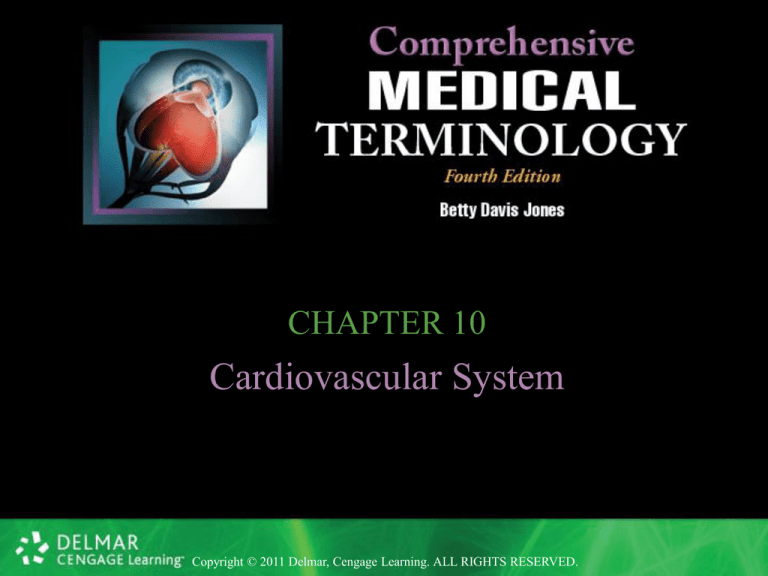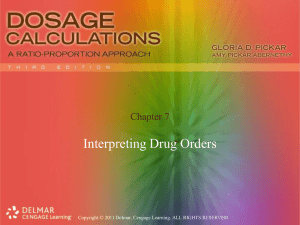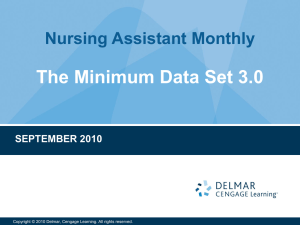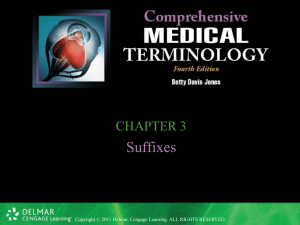
CHAPTER 10
Cardiovascular System
Copyright © 2011 Delmar, Cengage Learning. ALL RIGHTS RESERVED.
Cardiovascular System Overview
• Responsibilities of cardiovascular system
– Pumping blood to the body tissues and cells
– Supplying oxygen and nutrients to tissues and cells
– Removing carbon dioxide and other waste products of
metabolism from tissues and cells
Copyright © 2011 Delmar, Cengage Learning. ALL RIGHTS RESERVED.
Cardiovascular System
• Heart
– Center of the circulatory system
– Enclosed by pericardium
• Parietal pericardium
• Visceral pericardium
• Pericardial cavity
Copyright © 2011 Delmar, Cengage Learning. ALL RIGHTS RESERVED.
Cardiovascular System
• Heart
– Three layers of the heart
• Epicardium
• Myocardium
• Endocardium
Copyright © 2011 Delmar, Cengage Learning. ALL RIGHTS RESERVED.
Heart
• Chambers
– Right atrium and left atrium
• Upper chambers
• Receiving chambers
– Right ventricle and left ventricle
• Lower chambers
• Pumping chambers
Copyright © 2011 Delmar, Cengage Learning. ALL RIGHTS RESERVED.
Heart
• Partitions
– Interatrial septum
• Separates right and left sides of atria
– Interventricular septum
• Separates right and left sides of ventricles
Copyright © 2011 Delmar, Cengage Learning. ALL RIGHTS RESERVED.
Question
Which layer of the heart is required for muscle
contraction?
a.
b.
c.
d.
epicardium
endocardium
myocardium
pericardium
Copyright © 2011 Delmar, Cengage Learning. ALL RIGHTS RESERVED.
Circulation Through the Heart
• Deoxygenated blood
– Enters right atrium from superior vena cava
• Brings blood from head, thorax, upper limbs, and abdominal
viscera
– Also enters right atrium from inferior vena cava
• Brings blood from the trunk, lower limbs, and abdominal viscera
Copyright © 2011 Delmar, Cengage Learning. ALL RIGHTS RESERVED.
Circulation Through the Heart
• Deoxygenated blood travels:
– From right atrium through tricuspid valve into right
ventricle
– From right ventricle through pulmonary valve into right
and left pulmonary arteries
Copyright © 2011 Delmar, Cengage Learning. ALL RIGHTS RESERVED.
Circulation Through the Heart
• Deoxygenated blood travels:
– From pulmonary arteries to lungs
• Pulmonary arteries are the only arteries that carry deoxygenated
blood
• Exchange of gases takes place in the lungs
Copyright © 2011 Delmar, Cengage Learning. ALL RIGHTS RESERVED.
Circulation Through the Heart
• Oxygenated blood
– Enters left atrium from lungs via pulmonary veins
• Pulmonary veins are only veins in body that carry oxygenated
blood
– From left atrium through mitral valve into left ventricle
– From left ventricle through aortic valve into aorta
– From aorta to arteries to each body part and region
Copyright © 2011 Delmar, Cengage Learning. ALL RIGHTS RESERVED.
Circulation Through the Heart
• Pulmonary circulation
– Circulation of blood from the heart to the lungs for
oxygenation and back to the heart
• Systemic circulation
– Circulation of blood from the heart to all parts of the
body and back to the heart
Copyright © 2011 Delmar, Cengage Learning. ALL RIGHTS RESERVED.
Circulation Through the Heart
• Coronary arteries
– Arise from aorta near its origin at left ventricle
– Supply blood to heart muscle
– Heart muscle has a greater need for oxygen and nutrients
• Heart uses approximately 3 times more oxygen than other body
organs
Copyright © 2011 Delmar, Cengage Learning. ALL RIGHTS RESERVED.
Circulation Through the Heart
Copyright © 2011 Delmar, Cengage Learning. ALL RIGHTS RESERVED.
Question
True or False: Getting oxygenated blood to the
lungs is vital to other body systems.
Copyright © 2011 Delmar, Cengage Learning. ALL RIGHTS RESERVED.
Conduction System of the Heart
• Sinoatrial node (SA node) sets rhythm for
entire heart
– SA node = pacemaker of the heart
– Impulse from SA node causes atria to contract
• Impulse travels from SA node to
atrioventricular node (AV node)
Copyright © 2011 Delmar, Cengage Learning. ALL RIGHTS RESERVED.
Conduction System of the Heart
• Impulse from AV node travels to ventricles
through bundle of His
– Bundle of His divides into right and left bundle branches
• Bundle branches terminate in Purkinje fibers
– Purkinje fibers fan out into the muscles of the ventricles
– Purkinje fibers cause ventricles to contract
Copyright © 2011 Delmar, Cengage Learning. ALL RIGHTS RESERVED.
Conduction System of the Heart
Copyright © 2011 Delmar, Cengage Learning. ALL RIGHTS RESERVED.
Supporting Blood Vessels
• Arteries
– Large, thick-walled vessels
– Carry blood away from the heart
• Arterioles
– Thinner walls than arteries
– Transport blood on to capillaries
Copyright © 2011 Delmar, Cengage Learning. ALL RIGHTS RESERVED.
Supporting Blood Vessels
• Capillaries
– Extremely thin walls = single layer
– Allow for exchange of materials between blood and
tissue fluid surrounding body cells
Copyright © 2011 Delmar, Cengage Learning. ALL RIGHTS RESERVED.
Supporting Blood Vessels
• Venules
– Smallest veins
– Collect deoxygenated blood from cells for transport back
to heart
• Veins
– Thinner walls than arteries
– Thicker walls than capillaries
– Transport blood from venules to heart
Copyright © 2011 Delmar, Cengage Learning. ALL RIGHTS RESERVED.
Question
In looking at the diagram of the heart, what is
unique about the pulmonary arteries and
veins?
a. Nothing else uses “pulmonary” in the name.
b. The arteries carry deoxygenated blood and veins carry
oxygenated blood.
c. Each is connected to the opposite lung.
d. There is nothing unique about them.
Copyright © 2011 Delmar, Cengage Learning. ALL RIGHTS RESERVED.
Cardiac Cycle
• One cardiac cycle = one complete heartbeat
• Diastole
– Relaxation phase of heartbeat
– Ventricles relax and fill with blood
• Systole
– Contraction phase of heartbeat
– Ventricles contract and force blood out of heart
Copyright © 2011 Delmar, Cengage Learning. ALL RIGHTS RESERVED.
Blood Pressure
• Blood pressure
– Pressure exerted by blood on walls of arteries
• Systolic pressure
– Maximum pressure reached within the ventricles
Copyright © 2011 Delmar, Cengage Learning. ALL RIGHTS RESERVED.
Blood Pressure
• Diastolic pressure
– Minimum pressure reached within the ventricles
• Sphygmomanometer = blood pressure cuff
– Used to measure blood pressure
Copyright © 2011 Delmar, Cengage Learning. ALL RIGHTS RESERVED.
Common Signs and Symptoms
• Symptoms that may indicate cardiovascular
problems
Anorexia
Anxiety
Bradycardia
Chest pain
Cyanosis
Dyspnea
Edema
Fatigue
Fever
Headache
Nausea
Pallor
Palpitation
Sweat
Tachycardia
Vomiting
----------
--------------- ---------
Copyright © 2011 Delmar, Cengage Learning. ALL RIGHTS RESERVED.
Weakness
PATHOLOGICAL CONDITIONS
Cardiovascular System
Copyright © 2011 Delmar, Cengage Learning. ALL RIGHTS RESERVED.
Angina Pectoris
• Pronounced
– (an-JYE-nah PECK-tor-is)
– (AN-jin-nah PECK-tor-is)
• Defined
– Severe pain and constriction about the heart, usually
radiating to left shoulder and down left arm
• Creates feeling of pressure in anterior chest
Copyright © 2011 Delmar, Cengage Learning. ALL RIGHTS RESERVED.
Cardiac Tamponade
• Pronounced
– (KAR-dee-ak TAM-poh-nod)
• Defined
– Compression of the heart caused by accumulation of
blood or other fluid within the pericardial sac
• Accumulation of fluid in pericardial cavity prevents ventricles
from adequately filling or pumping blood
Copyright © 2011 Delmar, Cengage Learning. ALL RIGHTS RESERVED.
Cardiomyopathy
• Pronounced
– (kar-dee-oh-my-OP-ah-thee)
• Defined
– Disease of the heart muscle itself, primarily affecting
pumping ability of the heart
• Noninflammatory disease of the heart
• Results in enlargement of the heart and dysfunction of the
ventricles of the heart
Copyright © 2011 Delmar, Cengage Learning. ALL RIGHTS RESERVED.
Question
True or False: If a patient has angina pectoris,
the first concern is a heart attack.
Copyright © 2011 Delmar, Cengage Learning. ALL RIGHTS RESERVED.
Congestive Heart Failure
• Pronounced
– (kon-JESS-tiv heart failure)
• Defined
– Condition in which pumping ability of heart is
progressively impaired to the point that it no longer
meets bodily needs
Copyright © 2011 Delmar, Cengage Learning. ALL RIGHTS RESERVED.
Congestive Heart Failure
• Left-sided cardiac failure
– Left ventricle unable to pump blood that enters from the
lungs
Copyright © 2011 Delmar, Cengage Learning. ALL RIGHTS RESERVED.
Congestive Heart Failure
• Left-sided cardiac failure
– Characteristics:
•
•
•
•
•
•
Dyspnea
Moist sounding cough
Fatigue
Tachycardia
Restlessness
Anxiety
Copyright © 2011 Delmar, Cengage Learning. ALL RIGHTS RESERVED.
Congestive Heart Failure
• Right-sided cardiac failure
– Right side of heart cannot empty blood received from
venous circulation
– Characteristics:
• Edema of lower extremities (pitting edema)
• Weight gain
• Enlargement of liver (hepatomegaly)
Copyright © 2011 Delmar, Cengage Learning. ALL RIGHTS RESERVED.
Congestive Heart Failure
• Right-sided cardiac failure
– Characteristics:
•
•
•
•
•
Distended neck veins
Ascites
Anorexia
Nocturia
Weakness
Copyright © 2011 Delmar, Cengage Learning. ALL RIGHTS RESERVED.
Coronary Artery Disease
• Pronounced
– (KOR-oh-nah-ree AR-ter-ee dih-ZEEZ)
• Defined
– Narrowing of the coronary arteries to the extent that
adequate blood supply to the myocardium is prevented
Copyright © 2011 Delmar, Cengage Learning. ALL RIGHTS RESERVED.
Coronary Artery Disease
• Treatments for occluded coronary arteries
–
–
–
–
Medications
Percutaneous transluminal coronary angioplasty (PTCA)
Directional coronary atherectomy
Coronary bypass surgery = Coronary artery bypass graft
(CABG)
Copyright © 2011 Delmar, Cengage Learning. ALL RIGHTS RESERVED.
Endocarditis
• Pronounced
– (en-doh-car-DYE-tis)
• Defined
– Inflammation of the membrane lining of the valves and
chambers of the heart
• Caused by direct invasion of bacteria or other organisms
• Leads to deformity of valve cusps
Copyright © 2011 Delmar, Cengage Learning. ALL RIGHTS RESERVED.
Question
In coronary artery bypass grafting, what large
vessel is the main source of the new blood
supply?
a.
b.
c.
d.
vena cava
pulmonary artery
brachiocephalic artery
aorta
Copyright © 2011 Delmar, Cengage Learning. ALL RIGHTS RESERVED.
Hypertensive Heart Disease
• Pronounced
– (high-per-TEN-siv heart dih-ZEEZ)
• Defined
– Heart disease as a result of long-term hypertension
• Heart must work against increased resistance due to increased
pressure in the arteries
Copyright © 2011 Delmar, Cengage Learning. ALL RIGHTS RESERVED.
Mitral Valve Prolapse
• Pronounced
– (MY-tral valve proh-LAPS)
• Defined
– Drooping of one or both cusps of the mitral valve back
into the left atrium during ventricular systole
• Results in incomplete closure of the valve and mitral
insufficiency
Copyright © 2011 Delmar, Cengage Learning. ALL RIGHTS RESERVED.
Myocardial Infarction
• Pronounced
– (my-oh-KAR-dee-al in-FARK-shun)
• Defined
– Condition caused by occlusion of one or more of the
coronary arteries = destruction of myocardial tissue
– Heart attack
• Life-threatening condition
Copyright © 2011 Delmar, Cengage Learning. ALL RIGHTS RESERVED.
Myocarditis
• Pronounced
– (my-oh-kar-DYE-tis)
• Defined
– Inflammation of the myocardium
• May be viral or bacterial infection
• May be result of systemic disease
• May be caused by fungal infections, serum sickness, or chemical
agent
Copyright © 2011 Delmar, Cengage Learning. ALL RIGHTS RESERVED.
Pericarditis
• Pronounced
– (per-ih-kar-DYE-tis)
• Defined
– Inflammation of the pericardium (saclike membrane) that
covers the heart muscle
• May be acute or chronic
Copyright © 2011 Delmar, Cengage Learning. ALL RIGHTS RESERVED.
Rheumatic Fever
• Pronounced
– (roo-MAT-ik fever)
• Defined
– Inflammatory disease that may develop as a delayed
reaction to insufficiently treated Group A beta-hemolytic
streptococcal infection of the upper respiratory tract
Copyright © 2011 Delmar, Cengage Learning. ALL RIGHTS RESERVED.
Question
True or False: Another term for the backflow
of blood into the left atrium is regurgitation.
Copyright © 2011 Delmar, Cengage Learning. ALL RIGHTS RESERVED.
PATHOLOGICAL CONDITIONS
Blood Vessels
Copyright © 2011 Delmar, Cengage Learning. ALL RIGHTS RESERVED.
Aneurysm
• Pronounced
– (AN-yoo-rizm)
• Defined
– Localized dilatation of an artery formed at a weak point
in the vessel wall
• Weakened area balloons out with each pulsation of artery
Copyright © 2011 Delmar, Cengage Learning. ALL RIGHTS RESERVED.
Arteriosclerosis
• Pronounced
– (ar-tee-ree-oh-skleh-ROH-sis)
• Defined
– Arterial condition in which there is thickening,
hardening, and loss of elasticity of the walls of arteries
(hardening of the arteries)
• Results in decreased blood supply, especially to lower
extremities and cerebrum
Copyright © 2011 Delmar, Cengage Learning. ALL RIGHTS RESERVED.
Hypertension
• Pronounced
– (high-per-TEN-shun)
• Defined
– Condition in which the patient has a higher blood
pressure than judged to be normal
• Blood pressure persistently exceeds 140/90 mmHg
Copyright © 2011 Delmar, Cengage Learning. ALL RIGHTS RESERVED.
Hypertension
• Essential hypertension
– Accounts for 90 percent of all hypertension
– No single known cause
• Secondary hypertension
– Due to underlying cause
• Malignant hypertension
– Severe and rapidly progressive
– Diastolic pressure higher than 120 mmHg
Copyright © 2011 Delmar, Cengage Learning. ALL RIGHTS RESERVED.
Peripheral Arterial Occlusive Disease
• Pronounced
– (per-IF-er-al ar-TEE-ree-al oh-KLOO-siv dih-ZEEZ)
• Defined
– Obstruction of the arteries in the extremities
(predominantly the legs)
• Leading cause = atherosclerosis
• Classic symptom = intermittent claudication
Copyright © 2011 Delmar, Cengage Learning. ALL RIGHTS RESERVED.
Raynaud’s Phenomenon
• Pronounced
– (ray-NOZ feh-NOM-eh-non)
• Defined
– Intermittent attacks of vasoconstriction of the arterioles
• Causes pallor of the fingers or toes, followed by cyanosis, then
redness before returning to normal color (white-blue-red)
• Initiated by exposure to cold or emotional disturbance
Copyright © 2011 Delmar, Cengage Learning. ALL RIGHTS RESERVED.
Question
What would be the term for surgical removal
of an aneurysm?
a.
b.
c.
d.
aneurysmectomy
aneurysmoectomy
aneurysmotomy
aneurysmoplasty
Copyright © 2011 Delmar, Cengage Learning. ALL RIGHTS RESERVED.
Thrombophlebitis
• Pronounced
– (throm-boh-fleh-BYE-tis)
• Defined
– Inflammation of a vein associated with the formation of
a thrombus (clot)
• Usually occurs in an extremity, most frequently a leg
Copyright © 2011 Delmar, Cengage Learning. ALL RIGHTS RESERVED.
Thrombophlebitis
• Superficial thrombophlebitis
– Usually obvious
– Accompanied by cordlike or thready appearance to the
vessel
• Deep vein thrombosis (DVT)
– Occurs primarily in lower legs, thighs, and pelvic area
– Characterized by aching or cramping pain in legs
Copyright © 2011 Delmar, Cengage Learning. ALL RIGHTS RESERVED.
Varicose Veins
• Pronounced
– (VAIR-ih-kohs veins)
• Defined
– Enlarged, superficial veins
– Twisted, dilated veins with incompetent valves
Copyright © 2011 Delmar, Cengage Learning. ALL RIGHTS RESERVED.
Varicose Veins
• Treatment
– Rest and elevation of affected extremity
– Use of elastic stockings
– Sclerotherapy
• Injection of a chemical irritant into the varicosed vein
(sclerosing agent)
– Vein stripping
Copyright © 2011 Delmar, Cengage Learning. ALL RIGHTS RESERVED.
Varicose Veins
Copyright © 2011 Delmar, Cengage Learning. ALL RIGHTS RESERVED.
Venous Insufficiency
• Pronounced
– (VEE-nuss in-soo-FISH-in-see)
• Defined
– An abnormal circulatory condition characterized by
decreased return of venous blood from the legs to the
trunk of the body
Copyright © 2011 Delmar, Cengage Learning. ALL RIGHTS RESERVED.
Question
True or False: Venous insufficiency is not as
severe as varicose veins.
Copyright © 2011 Delmar, Cengage Learning. ALL RIGHTS RESERVED.
PATHOLOGICAL CONDITIONS
Congenital Heart Diseases
Copyright © 2011 Delmar, Cengage Learning. ALL RIGHTS RESERVED.
Coarctation of the Aorta
• Pronounced
– (koh-ark-TAY-shun of the aorta)
• Defined
– Congenital heart defect characterized by a localized
narrowing of the aorta
• Results in increased blood pressure in upper extremities and
decreased blood pressure in lower extremities
Copyright © 2011 Delmar, Cengage Learning. ALL RIGHTS RESERVED.
Patent Ductus Arteriosus
• Pronounced
– (PAY-tent DUCK-tus ar-tee-ree-OH-sis)
• Defined
– Abnormal opening between the pulmonary artery and the
aorta caused by failure of fetal ductus arteriosus to close
after birth
• Defect seen primarily in premature infants
Copyright © 2011 Delmar, Cengage Learning. ALL RIGHTS RESERVED.
Tetralogy of Fallot
• Pronounced
– (teh-TRALL-oh-jee of fal-LOH)
• Defined
– Congenital heart anomaly that consists of four defects
•
•
•
•
Pulmonary stenosis
Interventricular septal defect
Dextraposition of aorta (shifts to the right)
Hypertrophy of right ventricle
Copyright © 2011 Delmar, Cengage Learning. ALL RIGHTS RESERVED.
Transposition of the Great Vessels
• Pronounced
– (tranz-poh-ZIH-shun of the great vessels)
• Defined
– Condition in which the two major arteries of the heart
are reversed in position
• Results in two noncommunicating circulatory systems
Copyright © 2011 Delmar, Cengage Learning. ALL RIGHTS RESERVED.
Question
Which of the congenital abnormalities
mentioned require surgical correction?
a.
b.
c.
d.
tetralogy of Fallot
patent ductus arteriosus
coarctation of the aorta
all of them
Copyright © 2011 Delmar, Cengage Learning. ALL RIGHTS RESERVED.
PATHOLOGICAL CONDITIONS
Arrhythmias
Copyright © 2011 Delmar, Cengage Learning. ALL RIGHTS RESERVED.
Atrial Flutter
• Pronounced
– (AY-tree-al flutter)
• Defined
– Condition in which the contractions of the atria become
extremely rapid, at the rate of between 250 to 350 beats
per minute
Copyright © 2011 Delmar, Cengage Learning. ALL RIGHTS RESERVED.
Fibrillation (Atrial Fibrillation)
• Pronounced
– (atrial fih-brill-AY-shun)
• Defined
– Extremely rapid, incomplete contractions of the atria
resulting in disorganized and uncoordinated twitching of
the atria
• Rate of contractions may be as high as 350 to 600 beats per
minute
Copyright © 2011 Delmar, Cengage Learning. ALL RIGHTS RESERVED.
Fibrillation (Ventricular Fibrillation)
• Pronounced
– (ven-TRIK-yoo-lar fih-brill-AY-shun)
Copyright © 2011 Delmar, Cengage Learning. ALL RIGHTS RESERVED.
Fibrillation (Ventricular Fibrillation)
• Defined
– Rapid, tremulous (quivering like a bowl of Jell-O) and
ineffectual contractions of the ventricles
•
•
•
•
•
No audible heartbeat
No palpable pulse
No respiration
No blood circulation
If prolonged, will lead to cardiac arrest
Copyright © 2011 Delmar, Cengage Learning. ALL RIGHTS RESERVED.
Heart Block (AV)
• Pronounced
– (Heart Block)
• Defined
– An interference with the normal conduction of electric
impulses that control activity of the heart muscle
Copyright © 2011 Delmar, Cengage Learning. ALL RIGHTS RESERVED.
Ventricular Tachycardia
• Pronounced
– (ven-TRIK-yoo-lar tak-ee-KAR-dee-ah)
• Defined
– Condition in which the ventricles of the heart beat at a
rate greater than 100 beats per minute
– Characterized by 3 or more consecutive premature
ventricular contractions (PVCs)
– Also known as V-tach
Copyright © 2011 Delmar, Cengage Learning. ALL RIGHTS RESERVED.
Question
True or False: Ventricular fibrillation must be
corrected within 3 to 4 minutes, or the result
is death.
Copyright © 2011 Delmar, Cengage Learning. ALL RIGHTS RESERVED.
DIAGNOSTIC TECHNIQUES, TREATMENTS,
AND PROCEDURES
Cardiovascular System
Copyright © 2011 Delmar, Cengage Learning. ALL RIGHTS RESERVED.
Diagnostic Techniques, Treatments,
and Procedures
• Angiography
– X-ray visualization of internal anatomy of heart and
blood vessels after introducing a radiopaque substance
(contrast medium)
– Promotes imaging of internal structures that are
otherwise difficult to see on X-ray film
• Substance is injected into an artery or a vein
Copyright © 2011 Delmar, Cengage Learning. ALL RIGHTS RESERVED.
Diagnostic Techniques, Treatments,
and Procedures
• Cardiac catheterization
– Diagnostic procedure in which a catheter is introduced
into a large vein or artery, usually of an arm or a leg, and
is then threaded through the circulatory system to the
heart
• Used to obtain detailed information about the structure and
function of the heart chambers, valves, and the great vessels
Copyright © 2011 Delmar, Cengage Learning. ALL RIGHTS RESERVED.
Diagnostic Techniques, Treatments,
and Procedures
• Cardiac enzymes test
– Tests performed on samples of blood obtained by
venipuncture to determine the presence of damage to the
myocardial muscle
• (CAT) Computed axial tomography
– Diagnostic X-ray technique that uses ionizing radiation
to produce a cross-sectional image of the body
• Often used to detect aneurysms of the aorta
Copyright © 2011 Delmar, Cengage Learning. ALL RIGHTS RESERVED.
Diagnostic Techniques, Treatments,
and Procedures
• Echocardiography
– Diagnostic procedure for studying the structure and
motion of the heart
• Useful in evaluating structural and functional changes in a
variety of heart disorders
• Electrocardiogram (EKG, ECG)
– Graphic record of the electrical action of the heart as
reflected from various angles to the surface of the skin
Copyright © 2011 Delmar, Cengage Learning. ALL RIGHTS RESERVED.
Diagnostic Techniques, Treatments,
and Procedures
• Exercise stress testing
– Means of assessing cardiac function by subjecting the
patient to carefully controlled amounts of physical stress,
for example, using the treadmill
Copyright © 2011 Delmar, Cengage Learning. ALL RIGHTS RESERVED.
Diagnostic Techniques, Treatments,
and Procedures
• Holter monitoring
– Small, portable monitoring device that makes prolonged
electrocardiograph recordings on a portable tape recorder
• Continuous EKG (ambulatory EKG) is recorded on a magnetic
tape recording while the patient conducts normal daily activities
Copyright © 2011 Delmar, Cengage Learning. ALL RIGHTS RESERVED.
Question
A patient with angina pectoris has an abnormal
EKG and elevated cardiac enzymes.
__________________ is then performed to
determine the extent of cardiovascular disease.
a.
b.
c.
d.
Exercise stress testing
Cardiac catheterization
Holter monitoring
Computed axial tomography
Copyright © 2011 Delmar, Cengage Learning. ALL RIGHTS RESERVED.
Diagnostic Techniques, Treatments,
and Procedures
• Event monitor
– Similar to the Holter monitor in that it also records the
electrical activity of the heart while patient goes about
usual daily activities
– Can be used for a longer period of time than a Holter
monitor
• Usually a month
Copyright © 2011 Delmar, Cengage Learning. ALL RIGHTS RESERVED.
Diagnostic Techniques, Treatments,
and Procedures
• Implantable cardioverter defibrillator (ICD)
– Small, lightweight, electronic device placed under the
skin or muscle in either the chest or abdomen to monitor
the heart’s rhythm
– If abnormal rhythm occurs, the ICD helps return the
heart to its normal rhythm
Copyright © 2011 Delmar, Cengage Learning. ALL RIGHTS RESERVED.
Diagnostic Techniques, Treatments,
and Procedures
• Magnetic resonance imaging (MRI)
– Use of strong magnetic field and radiofrequency waves
to produce imaging that is valuable in providing images
of the heart, large blood vessels, brain, and soft tissue
• Used to examine the aorta, to detect masses or possible tumors,
and pericardial disease
• Can also show the flowing of blood and the beating of the heart
Copyright © 2011 Delmar, Cengage Learning. ALL RIGHTS RESERVED.
Diagnostic Techniques, Treatments,
and Procedures
• Positron emission tomography (PET)
– Computerized X-ray technique that uses radioactive
substances to examine the blood flow and the metabolic
activity of various body structures, such as the heart and
blood vessels
• Patient is given doses of strong radioactive tracers by injection
or inhalation
• Radiation emitted is measured by the PET camera
Copyright © 2011 Delmar, Cengage Learning. ALL RIGHTS RESERVED.
Diagnostic Techniques, Treatments,
and Procedures
• Serum lipid
– Test that measures the amount of fatty substances
(cholesterol, triglycerides, and lipoproteins) in a sample
of blood obtained by venipuncture
• Thallium stress
– Combination of exercise stress testing with thallium
imaging to assess changes in coronary blood flow during
exercise
Copyright © 2011 Delmar, Cengage Learning. ALL RIGHTS RESERVED.
Question
True or False: The PET scanner is helpful in
detecting coronary artery disease, which is
less invasive than cardiac catheterization.
Copyright © 2011 Delmar, Cengage Learning. ALL RIGHTS RESERVED.







